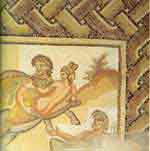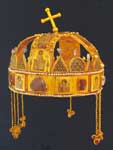|
A lot of what you see in Budapest is newer than it appears. Classical and Gothic buildings are for the most part neo-Classical and neo-Gothic. Even the much-trumpeted Budapest Baroque was flourishing a good few decades later than the Baroque in many other European countries. This is, of course, a direct result of Budapest's turbulent history. Wave upon wave of occupation and subsequent destruction has taken its toll and when each wave rolled on, it left surprisingly little in its wake.
|
 The Romans were here. The Emperor Trajan established military and civilian townships at Aquincum, a little way north of what is now central Budapest. The Emperor Diocletian built a fortress on the Danube bank in the 3rd Century AD, near the present day Elisabeth Bridge. Magyar tribes did not actually enter the Carpathian Basin until the late 9th century, when Árpad led his people down from the Caucasus. The ruling House of Árpad was then established and continued to rule for three centuries. The Romans were here. The Emperor Trajan established military and civilian townships at Aquincum, a little way north of what is now central Budapest. The Emperor Diocletian built a fortress on the Danube bank in the 3rd Century AD, near the present day Elisabeth Bridge. Magyar tribes did not actually enter the Carpathian Basin until the late 9th century, when Árpad led his people down from the Caucasus. The ruling House of Árpad was then established and continued to rule for three centuries.
|
 One of its heirs, King and later saint Stephen (István), converted the people to Christianity and received a crown from Pope Sylvester II in 1000, which has since symbolised the independent Hungarian state and its adherence to Catholicism rather than the Orthodoxy of its Slav neighbours. One of its heirs, King and later saint Stephen (István), converted the people to Christianity and received a crown from Pope Sylvester II in 1000, which has since symbolised the independent Hungarian state and its adherence to Catholicism rather than the Orthodoxy of its Slav neighbours.
|
|
|